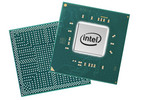
Chuwi GemiBook CWI528 Laptop Review: Full sRGB Coverage For $300 USD
Intel Celeron J4115 | Intel UHD Graphics 600 | 13.00" | 1.3 kg

The Intel Celeron J4115 is a quad-core SoC primarily for inexpensive mini PCs and was announced late 2017. It runs at 1.8 GHz to 2.5 GHz (Single Core Burst) and is based on the Gemini Lake platform. Similar to the Apollo Lake predecessors, the chip is manufactured on a 14 nm process with FinFETs but offers slightly improved processor cores, double the amount of L2 cache, all in a smaller package. Partial Wi-Fi 5 support is baked into the chip. Besides four CPU cores, the chip also includes a DirectX 12 capable GPU as well as a DDR4/LPDDR4 memory controller (dual-channel, up to 2400 MHz). The processor is not replaceable as it is directly soldered to the mainboard.
Architecture
The processor architecture ist still called Goldmont Plus. Compared to the older Goldmont cores in Apollo Lake, they feature a larger L2 cache (now 4 MB). That means the per-clock-performance should be a bit better, but not anywhere near the Core CPUs like Kaby Lake Y.
Performance
The average J4115 in our database only just matches the Core i5-4260U, a somewhat more power-hungry SoC that saw the light of day in 2014, in multi-thread performance. This means the Celeron is a very basic CPU that isn't really ready to handle anything beyond the most basic tasks such as writing e-mails and listening to Spotify.
Graphics
The UHD Graphics 600 (Gemini Lake) is based on Intel's Generation 9 architecture, which supports DirectX 12 and is also used for the Kaby Lake / Skylake / Apollo Lake graphics adapters (like HD Graphics 520). Equipped with 12 EUs and a clock of up to 750 MHz, the performance should be roughly on par with the older HD Graphics 500 (Apollo Lake).
The chip also includes an advanced video engine with hardware support for the playback of VP9 and H.265 (8-bit color-depth).
Power consumption
Like most other J-class Intel processors, the Celeron has a default TDP (also known as the long-term power limit) of 10 W. This is low enough to allow laptop makers to build passively cooled laptops, mini-PCs, tablets and other gadgetry around the chip.
The Intel Celeron J4115 is built with one of the old 14 nm Intel processes for poor, as of early 2023, energy efficiency.
| Codename | Gemini Lake | ||||||||||||||||||||||||||||
| Series | Intel Gemini Lake | ||||||||||||||||||||||||||||
Series: Gemini Lake Gemini Lake
| |||||||||||||||||||||||||||||
| Clock Rate | 1800 - 2500 MHz | ||||||||||||||||||||||||||||
| Level 2 Cache | 4 MB | ||||||||||||||||||||||||||||
| Number of Cores / Threads | 4 / 4 | ||||||||||||||||||||||||||||
| Power Consumption (TDP = Thermal Design Power) | 10 Watt | ||||||||||||||||||||||||||||
| Manufacturing Technology | 14 nm | ||||||||||||||||||||||||||||
| Max. Temperature | 105 °C | ||||||||||||||||||||||||||||
| Socket | BGA1090 | ||||||||||||||||||||||||||||
| Features | DDR4-2400/LPDDR4-2400 RAM, PCIe 2, MMX, SSE, SSE2, SSE3, SSSE3, SSE4.1, SSE4.2, VMX, SMEP, SMAP, MPX, EIST, TM1, TM2, Turbo, AES-NI, RDRAND, RDSEED, SHA, SGX | ||||||||||||||||||||||||||||
| GPU | Intel UHD Graphics 600 (250 - 750 MHz) | ||||||||||||||||||||||||||||
| 64 Bit | 64 Bit support | ||||||||||||||||||||||||||||
| Architecture | x86 | ||||||||||||||||||||||||||||
| Announcement Date | 11/04/2019 | ||||||||||||||||||||||||||||
| Product Link (external) | ark.intel.com | ||||||||||||||||||||||||||||


Chuwi GemiBook CWI528: Intel UHD Graphics 600, 13.00", 1.3 kg
External Review » Chuwi GemiBook CWI528
» Chuwi GemiBook design flaw shows us what happens when ports are positioned too closely together
Chuwi LarkBox 4K Mini PC: Intel UHD Graphics 600, 0.1 kg
» Lemon-sized Chuwi LarkBox 4K mini PC is finally live at $155 USD and set for an August launch window
» Mobile CPU Comparison
Comparison of all mobile CPU series
» Mobile Processors - Benchmarklist
Benchmarklist of all known CPUs that are used in laptops (desktop and laptop CPUs)
Top 10 Laptops
Multimedia, Budget Multimedia, Gaming, Budget Gaming, Lightweight Gaming, Business, Budget Office, Workstation, Subnotebooks, Ultrabooks, Chromebooks
under 300 USD/Euros, under 500 USD/Euros, 1,000 USD/Euros, for University Students, Best Displays
Top 10 Smartphones
Smartphones, Phablets, ≤6-inch, Camera Smartphones